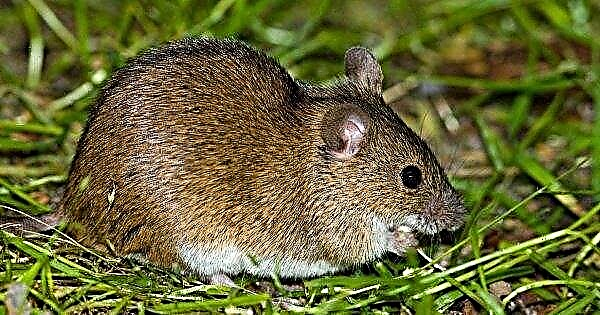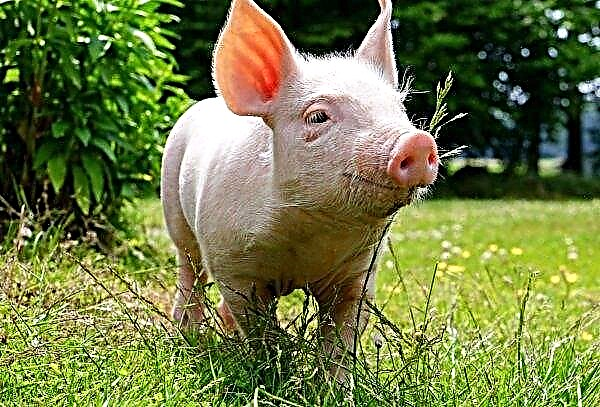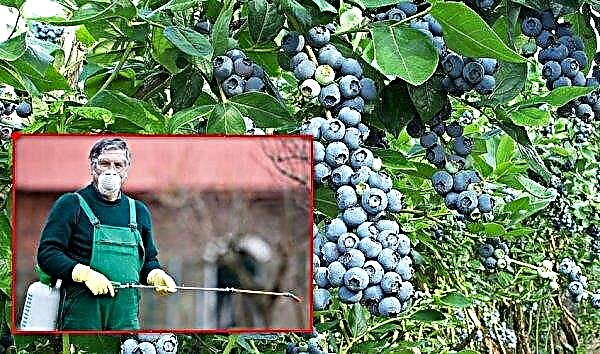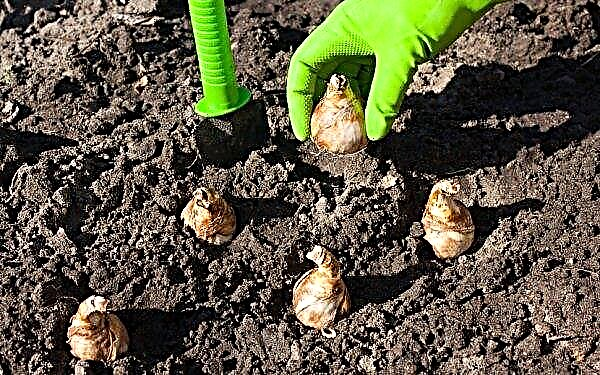Any animals, one way or another, are susceptible to all kinds of diseases. From some of them immunity is developed; from others, salvation has not yet been found. Such dangerous ailments include leukemia, which affects the circulatory system of animals. In our article, we will understand what leukemia is in cows, how it is transmitted, who is its causative agent, how to identify a sick individual and what measures for its treatment and isolation from a healthy livestock should be used, as well as methods of preventive measures.
What is leukemia in cows?
Leukemia in any animals, including cows, causes the virus of the same name. And if it was previously believed that this disease does not pose a danger to humans, then recent studies have shown that it is still able to exert certain negative phenomena, and therefore today research on this phenomenon continues, because in the world there is no such kind of cows that would be genetically protected from the leukemia virus and had immunity against it. Such a viral bacterium penetrates the circulatory system and produces a general infection of the cow’s body, rapidly spreading through the blood channels and penetrating into all internal organs, subsequently parasitizing on them and leading to the death of the animal.
How is transmitted
There are several main ways and methods of transmitting leukemia virus between individual livestock individuals, among which are the following:
- in case of direct contact of infected individuals with other representatives of the herd;
- through the same cleaning equipment throughout the entire farm;
- through bites of blood-sucking insects (ticks, horseflies, mosquitoes);
- in case of infection of the manufacturing bull, the virus can be transmitted through semen during mating;
- in some cases, transmitted from a sick mother to a calf in utero.
Did you know? The most expensive meat in the world is marbled beef obtained from Japanese cows of the Wagu breed. The Japanese treat these animals with great respect and daily feed them with the best herbs, drink beer and rub sake.
Stages and Symptoms
There are three main stages of infection: incubation, hematological and tumor. Each of these stages is characterized by certain signs and symptoms, which we will discuss in more detail.
Incubation
This stage got its name because during this period leukemia viruses penetrate the body of a healthy cow, becoming parasites inside its circulatory system. At this time, the bacteria are saturated with nutrients, gaining their strength and sucking life juices from the animal. During this period, the cow does not show any external signs of the disease. She remains calm, continues to give large milk yields, and the viruses in her incubation do not produce any negative effects on her general condition.
Important! At this stage, infection can only be determined by passing a general blood test.
Hematologic
The second stage, called hematological, can already give some external symptoms by which the host can determine the sick individual. Due to the destructive effects on the circulatory system, bruising can occur on the body, and especially on the udder and abdominal part. Such hematomas are caused by a breakthrough of the blood channels and internal hemorrhage.
In itself, such a phenomenon is harmless, but it serves as a signal for action. Such hemorrhages are not reflected in the general condition of the cow. Similar dark spots can also appear due to bruises of the animal. Thus, if the hematoma is a single character, then you should not worry, but if you notice several hemorrhages, then it is better to play it safe and take tests.
Tumor
The final stage of leukemia is called the tumor. Right now, visible symptoms appear, such as enlarged lymph nodes, decreased immunity, exhaustion, enlarged spleen, and low productivity. After opening the dead individual, it is found that the entire body inside and all internal organs are affected by multiple tumors, which led to the death of the animal.
Diagnostics
In order to timely and correctly diagnose the presence of leukemic cells in the body of horned animals, some generally mandatory measures should be taken, which include:
- Immunodiffusion reaction (RID). With this test method, blood sampling is performed on the 15th day after checking for tuberculosis, as well as 30 days before and after calving. For the study, the blood of any animal, whose age is more than six months, is suitable. If the reaction is positive, then the animal is considered a virus carrier of leukemia.
- Hematological method. It uses a method of counting the number of lymphocytes in the blood. For 36 hours after blood sampling, a laboratory analysis is performed. In case of doubtful results, this examination is repeated after two months. It also happens that after a second study, the number of lymphocytes decreases in comparison with the initial analysis. This suggests that the stage of remission of the disease has begun and in the future the number of lymphocytes may increase significantly.
Did you know? At the moment, scientists have identified two main forms of the disease caused by the leukemia virus in cattle. One of them is sporadic, which is extremely rare. Its distinguishing feature is that it affects young calves under the age of 3 years. Another form, called enzootic leukemia, is much wider and affects adult cows and bulls. It is dangerous because it proceeds without visible symptoms for quite a long time. When it is discovered, it is already too late to do anything. Enzootic form can be determined only after a general blood test of the animal.
What to do with a sick animal
After opening or slaughter, it becomes clear whether the body was affected by the leukemia virus. Numerous tumors that covered all the inside of a horned animal should be a signal that this individual was sick, which means that her carcass needs to be urgently destroyed. Disposal can be made by burying the dead individual in the ground or burned at the stake. If the disease was discovered before the death of the cow, then such an animal must be immediately isolated from the rest of the herd. It is placed in a separate stall, childbirth is carried out in a separate room, grazing and walking are also carried out separately from the herd.
If the disease was discovered before the death of the cow, then such an animal must be immediately isolated from the rest of the herd. It is placed in a separate stall, childbirth is carried out in a separate room, grazing and walking are also carried out separately from the herd.
In accordance with the law, on the farm where a sick cow is found, comprehensive surveys of the rest of the livestock are carried out in order to identify other possibly sick animals. The sick are isolated and subsequently kept in separate stalls from a healthy herd in order to exclude the possibility of contact.
Important! To date, no universal medicine has been developed to cope with the leukemia virus. The thing is that the virus infects lymphocytes, and to cope with it, you need to destroy the lymphocytes themselves, which will lead to immunodeficiency. The result of such treatment will lead to AIDS symptoms. And therefore, such a disease is considered incurable.
In addition, a number of restrictions and prohibitions are introduced, including:
- a ban on the joint placement of infected individuals with healthy animals;
- a ban on the use of meat and dairy products for food from sick cows;
- a ban on changing the place of quarantine isolation for sick animals within a settlement without the knowledge of the veterinary service;
- a ban on the sale of meat and dairy products from sick cows.
Is it possible to drink milk and eat meat
By itself, the leukemia virus is not transmitted from a cow to a person, but it is forbidden to eat meat or dairy products from a sick cow. The thing is that such products carry a danger in the form of the formation and development of cancer cells, which in the future can lead to the progression of cancer. Carcinogenic waste products of viral cells are formed and accumulate in meat and milk of sick horned animals. They are the ones that pose a danger to humans. Although healthy calves are born in sick cows, nevertheless, the milk of these domestic animals should be subjected to prolonged boiling, after which they should be used only for feeding young animals.
Carcinogenic waste products of viral cells are formed and accumulate in meat and milk of sick horned animals. They are the ones that pose a danger to humans. Although healthy calves are born in sick cows, nevertheless, the milk of these domestic animals should be subjected to prolonged boiling, after which they should be used only for feeding young animals.
Important! Eating milk from an infected cow is prohibited even after pasteurization.
Prevention
In order to prevent the emergence and development of such a dangerous disease as leukemia in cattle, certain prevention rules should be applied, which are listed for convenience in the list:
- Compliance with the rules of general sanitation, regular cleaning and antibacterial treatment of rooms where cattle are kept.
- Conducting scheduled analyzes and examinations of the livestock with a frequency of twice a year, starting from six months of age.
- The sale of new products in a herd of animals is allowed only 30 days after the serological analysis with a negative result.
- Affected individuals should be quarantined immediately after the discovery of the disease.
- All animals in the herd, when detecting leukemia in one of the individuals, are also subjected to repeated testing. Those infected are quarantined or killed.
- From the moment of the first infection focus, the entire population of RID-negative animals is checked at an interval of 30 days to prevent a repeat epidemic.
- Up to 15 days from the date of detection of leukemia, RID-positive individuals are subject to destruction.
 The timely detection of leukemia in cattle will help prevent the occurrence of mass infection and mortality, and therefore it is necessary to strictly adhere to the accepted rules for the prevention and passage of tests at the prescribed time. As for the question whether leukemia is dangerous for humans, the danger of meat and dairy products from infected animals should be noted here, because they can cause the development of oncology. Do not risk your health and the health of your loved ones. Infected cows should be immediately slaughtered and all necessary measures should be taken to dispose of possible sources of leukemia.
The timely detection of leukemia in cattle will help prevent the occurrence of mass infection and mortality, and therefore it is necessary to strictly adhere to the accepted rules for the prevention and passage of tests at the prescribed time. As for the question whether leukemia is dangerous for humans, the danger of meat and dairy products from infected animals should be noted here, because they can cause the development of oncology. Do not risk your health and the health of your loved ones. Infected cows should be immediately slaughtered and all necessary measures should be taken to dispose of possible sources of leukemia.












